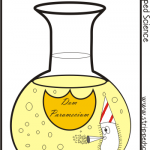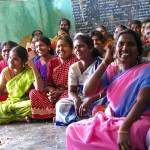microbiology
Thanks to Viktor at StrippedScience for letting me borrow his microbe New Year's cartoon!
Happy New Year! I was catching up on my blog reader and came across the NatureNews top science stories of 2010. I was curious how many of these stories would have something to do with microbes... turns out quite a few do. Of the 12 science news-worthy events/discoveries selected, 3 were directly related: the claim of Arsenic-based life story, the new HIV drug Truvada (including viruses with microbes), and the synthetic genome from the Ventner institute.
In the style of 6 degrees of Kevin Bacon I…
So Google has released this Ngram thingee that searches for words in all of the archived Google stuff. So I decided to look for the words "MRSA", "staphylococcus", and "Staphylococcus." Here's what I found:
You'll note that both staphylococcus and Staphylococcus surge around the same time as the influenza pandemic of 1918. What's odd though is that if we drill into the years 1910-1920, the highest use of both words is around 1913, although it doesn't decrease much until after 1920. Presumably, bloodstream infections (sepsis) from WWI, followed by the influenza pandemic--in which…
Scientists including the news media in the process of discovery is a volatile affair, as we have all witnessed recently. My fellow bloggers on ScienceBlogs, We Beasties, discussed the role of bloggers and scientists in the process of the NASA scientists announcing their discovery of "arsenic-based life forms".
Generally speaking, as a scientist I have always been bothered by the idea of a press release to announce a scientific discovery before I had an opportunity to carefully review the study myself. Typically, a friend or neighbor would say "Hey, did you hear about the discovery of…
Adult human breast stem cells (red) are found in ductal regions. Lineage-restricted progenitor cell types (green) reside outside
Scientists based at a medical center in Berlin have accomplished something extraordinary: they have used stem cells to prevent viruses to grow in a patient infected with HIV. This patient had been taking antiviral drugs but discontinued them for the study. Since this patient had been on chemotherapy, the stem cell "transplant" was given to boost his immune system.
Here's the basic idea: A key part of our immune system is comprised of T cells. Some of these…
It's been interesting to watch as microbiology's own cold fusion debate has been raging. It began with an extraordinary claim about bacteria using arsenate as a replacement when phosphate concentrations are low (1).
It progressed when at least two scientist / bloggers ( here, and here) (not bloggers! the horrror! how uncivil!) gave public "journal club" presentations on blogs (envision dripping slime).
It continued with the science journalists lamenting about having swallowed the hype.
And it seemingly ended with another scientist / blogger's post that seemed to equate discussions…
Trine Tsouderos has done it again!
She is a one woman, woo-fighting machine!
She has taken on anti-vaxers.
She has taken on Dr. Oz.
She has taken on XMRV-->CFS.
And now shes goin after a rare wooity-- Chronic Lyme Disease:
Lyme disease is real. The bacterial infection, chiefly transmitted by deer ticks, can cause rashes, swollen joints and inflamed nerves, and usually is curable with a round of antibiotics.
But doctors around the country are telling patients with common medical problems such as back pain, poor concentration and fatigue that their ailments stem from a chronic form of Lyme…
I don't see the need to redescribe the recent paper about the discovery of bacteria that can might replace, in extremis, phosphorus with arsenic, which was overhyped by NASA, was poorly covered by most journalists, and which has compromising methodological problems (for good coverage, read here, here, and here; and snark). But what the paper does demonstrate is the importance of culturing microorganisms, knowledge about which is becoming rapidly lost by younger scientists.
With the advent of DNA-based, culture-independent techniques, where we can look at the DNA and RNA of microbes without…
Today's report of Arsenic-eating bacteria published in Science could have some unanticipated benefits: clean up and bioremediation after an oil spill. I may be off base, but here's my reasoning. Caveat: these newly discovered bacteria may not be useful in reducing arsenic levels after an oil spill if they are "fastidious" or too finicky to adapt to a marine environment. But then again, bacteria seem to always surprise us.
NASA Image Gulf Oil Spill
On May 24, 2010, the Advanced Spaceborne Thermal Emission and Reflection Radiometer (ASTER) on NASA's Terra satellite captured this false-…
Thanks, "We, Beasties" for your article on cholera.
As you pointed out:
As cholera rampages through Haiti, some epidemiologists are warning that the country could face more than half a million cases over the coming year. Yet tracking and treating the disease is proving increasingly difficult as civil unrest grips the county.
While oral vaccines are an effective approach to treating such epidemics, there is another potential tool that has proven to be effective in Bangladesh. Could this approach be used in Haiti to improve health outcomes?
Flickr mckaysavage's photostream
In a pursuit of…
NASA has made a bit of a stir by announcing a press conference for tomorrow at 2pm EST. Scientists are going to reveal some exciting new findings relvent to the search for extraterrestrial life. Some people are anticipating/hoping that they will announce that extraterrestrial life has been confirmed. No one would be more excited than I (I love being able to make silly statements like this) were that the case, but I would bet a lot of money that it is, sadly, not. Don't get me wrong, I am super-excited about this announcement because most likely it is going to deal with extremeophile…
Did you know that bacteria make up 90% of the cells in your body? That they make up ~5% of your mass? That they colonize you at the moment of birth and are different if you were born via c-section than if you were born naturally?
All this and more in the SITN production, "Our Microbial Organ: The good and bad bugs of the gut." And who's that handsom devil presenting (at least the first part)? Why, it's me!
Part 1: Living in a microbial world
2010 Fall Lecture 7.1: Our Microbial Organ: The Good and Bad Bugs of the Human Gut from Science in the News on Vimeo.
Part 2: Our Microbial Organ
Part 3…
Bioluminescince is amazing. I have seen it first hand barely noticeably in the wake of a ship at night, from a laboratory culture in a large flask, filling a Puerto Rican bay such that every fish darting or rain drop falling glows blue, and most recently in a 2 hour light show viewed through the window of the Alvin submersible on my descent into the Pacific ocean. I can tell you that it is always a crowd pleaser. The fact that microbes have generated biochemical pathways to produce light is amazing and awe inspiring. It may also, have some practical use for people, eventually.
Picture…
This is just awesome:
A strain of Escherichia coli bacteria can now solve [sudoku] puzzles
[...]
"Because sudoku has simple rules, we felt that maybe bacteria could solve it for us, as long as we designed a circuit for them to follow," says team leader Ryo Taniuchi.
The mechanism is ingenious and yet straightforward at the same time.
Basically, they have 16 different strains of bacteria, with each initial strain representing a spatial coordinate on a 4x4 grid. Each bacterium has a "4C3 leak" system, which is a chunk of DNA that the team designed that has 4 possible outputs. Depending on…
If you're in the Boston area, come see me (and two other awesome grad students) give a talk on microbes, especially the ones that live in you and on you.
We've got everything from fecal transplants to whether bacteria can make you fat or not. Come out to Armenise amphitheater at the Harvard Medical School at 7pm, you won't regret it!
A lot has been said, written, and discussed about the recent Oil Spill in the Gulf of Mexico. The spill has been capped but the damage remains. The Gulf of Mexico has now become the feedstock of several battles, fierce and feeble, in the legal, political and scientific realm. What battles you say? It's what on your mind as well - What will happen of the Gulf of Mexico? What do we need to do to save the physical, chemical and biological environment? And the worst of all - Is the damage irreversible?
Sadly, we don't have any answers yet. And let's face it - there is no right answer. What we do…
We beasties came together through our love of microbes, but also through a graduate student group called Science in the News. SITN is completely run by graduate students, and our mission (much like the mission of this blog) is to share our love of science with the general public. We have a lot of events to this end, from school out-reach to a monthly newsletter to Science Cafes (called "Science by the pint" - we basically get drunk and talk science with whoever happens to be in the bar). But our main event is a lecture series every fall.
And it just so happens that this week, I'll be…
And by hot, I mean employable. I'll get to that in a bit, but I first want to relate some history. Back when I was a wee lil' Mad Biologist, and molecular population genetics was in its infancy, there was a brief period where people had to be convinced that this stuff was useful (it was). Then it became fashionable, and the 'early adopters'--people who were regularly using PCR and clone-based sequencing (followed by S35 sequencing)--became hot intellectual commodities for about five years. Then the field became crowded, but 'good' molecular population geneticists (whatever 'good' means)…
A couple of weeks ago I attended the Human Microbiome Research Conference. At that meeting, one talk by Bruce Birren (and covered by Jonathan Eisen) mentioned something that was completely overlooked by the attendees. Now, I don't blame them, since what Birren mentioned was about bacterial genomics, not the human microbiome. But here's what I tweeted about Birren's talk (TWEET!):
B. Birren-E. coli K-12 can be assembled into 1 scaffold for hundreds of $s with Illumina seq & new jumps
Let's unpack this below the fold.
When we sequence a genome, we actually sequence small pieces (with the…
One of the constant assumptions in the field of antibiotic resistance is that the massive exposure of bacteria to antibiotics, and the evolution of resistance to these antibiotics, didn't occur until after the widespread introduction of penicillin and other antibiotics less than a century ago. But ScienceDaily reports that we might have to rethink this:
A chemical analysis of the bones of ancient Nubians shows that they were regularly consuming tetracycline, most likely in their beer....
In 1980, he discovered what appeared to be traces of tetracycline in human bones from Nubia dated between…
One of the common sayings in microbiology that drives me up a wall is the notion that 99% of all bacteria can't be grown in the lab. This false statement stems from the observation that if you take any sample (soil, water, clinical samples) and look under a microscope we see many more bacterial cells that contain DNA than we can grow. The problem is that, if you look at the paper that claimed this, they attempted to grow bacteria on a single, rich medium.
One weekend, when I was a post-doc, I did a very simple comparison. I took standard rich lab medium ('nutrient agar' which is basically…




